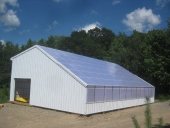Hey Jason.... glad to hear I'm not the only one over budget(but money is cheap and I got a sweet business loan if you need a biz plan to copy). We toyed around with various potential substrates for the SHCS as well as which style of vented plastic pipe. We decided on rigid PVC(to prevent any underground pipes from collapsing), crushed rock was used for its thermal mass and we worried about ground moisture causing a finer material to clog piping.
The raised beds are 2x8 rough cut, we chose wood over concrete for price and thermal mass(wood holds more than concrete). We will line the beds with UV stable plastic, fill half way with more stone(testing cobble vs. crushed rock), then about 16 inches of potting mix. this winter will be alot of data collection to gauge how well the SHCS works and how 2' beds compare to 3' beds, etc. If you are interested in following along on FB here is our page....
https://www.facebook.com/WellsvilleNyBiodynamicHenhouse?ref=hl






